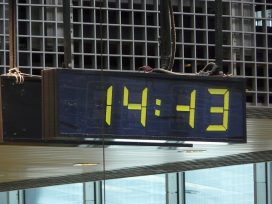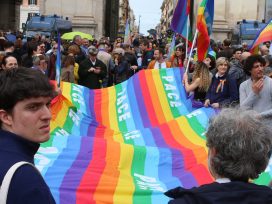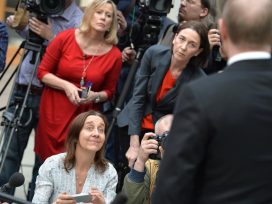Whose revolt is it?
The description of Russia’s anti-Putin protests of 2011–12 as ‘middle class’ was only partially accurate and used to discredit them. The middle class label applies even less to the Belarusian protests of 2020, whose core message is that dignity and respect are not reserved for a privileged minority.
It has been roughly three months since large-scale civic resistance started in Belarus, a response to falsified presidential election results claiming that Alexander Lukashenka, in power since 1994, won a sixth term. The prospects of the 2020 vote looked gloomy for the incumbent from the very beginning. After a quarter of a century as president, Lukashenka found himself cornered by a grim set of circumstances, many of his own creation: a decade-long economic stagnation, aggressive pressure from Russia, the shortage of state resources, the absence of a plan of the future development, and the coronavirus pandemic.
Still, the situation looked unfortunate but not quite catastrophic. The dictator invested hope in the same strategy that successfully got him through previous electoral cycles. It became apparent, however, that the predictable combination of election fraud, police violence, and political repression did not work as planned and failed to contain the protests. The situation currently resembles a standoff that could swing either way. For people in Belarus and external observers alike, the forecasts remain uncertain, yet, whatever their outcome, the protests have likely surpassed their initial expectations.
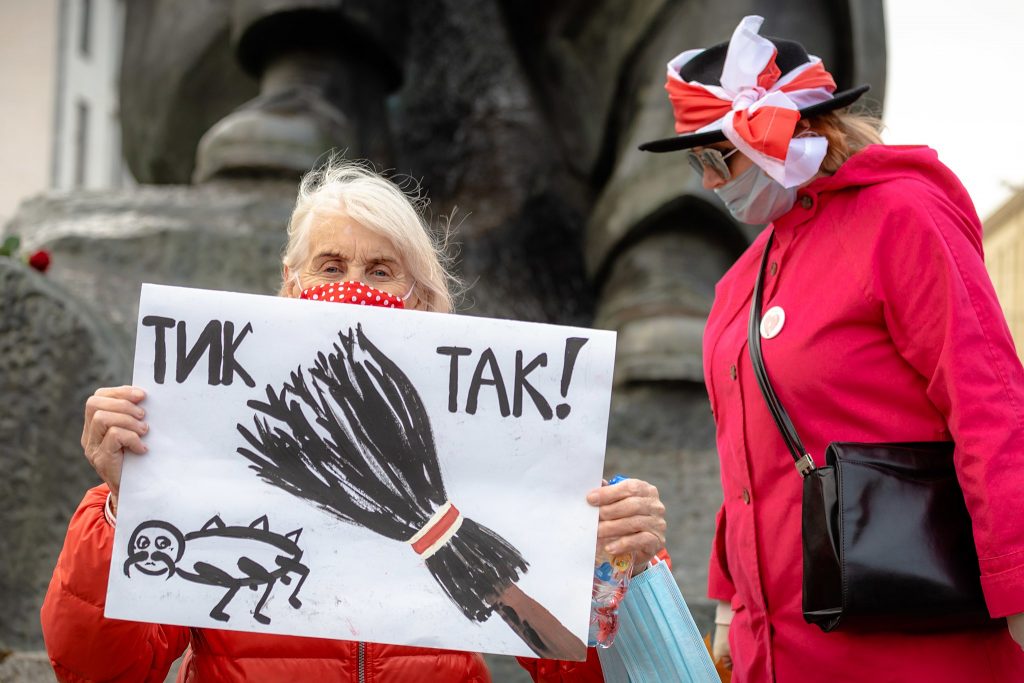
Max Katz, CC BY-SA 2.0 via Wikimedia Commons
Revolutions and ‘colour’ paranoia
Recent developments in Belarus have been particularly hard for outside observers to understand, since the country largely remained a terra incognita, rarely appearing in the spotlight. The state came to be primarily defined by its geographical and political proximity to Russia, firmly assigned to its ‘sphere of influence’. The Belarusian protests quickly entered the list of the major post-Soviet upheavals triggered by disputed elections, including Georgia, Ukraine, Kyrgyzstan, Russia, and Armenia.
Even in authoritarian regimes where election results are routinely falsified and voting is not considered the mechanism for governmental change, elections remain the main event in political life and the point of mobilisation for citizens and political forces, creating a moment for potential contestation. Regardless of whether the protests achieved regime change or not, these events have redefined the political life of these countries, demarcating a ‘before’ and ‘after’. At the same time, they have reshaped the broader political architecture of post-Soviet space by redrafting the lines of political alliances and regional power influences. Furthermore, these movements have forged the models of action and contestation to be adopted by protestors or resisted by other regimes.
The so-called ‘colour revolutions’ notably challenged the local status quo, but also became a major determinant of Russia’s domestic and the foreign politics. This state-successor of the Soviet empire recognised them as the major challenge to its internal stability and geopolitical ambitions, presuming foreign interference to be the true engine behind the popular uprisings. These discussions about large-scale political processes and geopolitical confrontations should not, however, eclipse how these movements emerged as the expression of both discontent and the hopes and aspirations of people on the ground.
In Russia, the post-election mass protests of 2011-2012 became one of the main challenges that the current political authorities have faced so far. Even without posing an immediate threat, the protest movement forced the regime to reinvent itself, leading to a general ‘conservative turn’, further entrenched by the aftermath of the ‘Revolution of Dignity’ in Ukraine. From then on, prospective new upheavals reshaping the post-Soviet region have remained high on political and public agendas. Belarus has always been a special case due to its particularly close dependence on Russia. These ties materialised in the political structures of the Union State of Russia and Belarus, the Eurasian Customs Union, and the strategic military cooperation in which Belarus figures as the Western frontier in Russia’s confrontation with NATO.
White ribbons and white bracelets
It is hardly surprising that making sense of the current explosion of civic resistance in Belarus has implied framing them in the context of its relationship with Russia. This has also prompted further comparisons between protest movements in these closely related states. In both countries, authoritarian leaders have held their positions for decades, achieving a significant consolidation of power, unlike in Armenia and Ukraine. Elections have, meanwhile, functioned as a tool for the reproduction of the regimes, and executive power has basically become unconstrained.
In the light of this, the protests that erupted after the December 2011 Russian parliamentary elections, continuing until the May 2012 presidential elections, seem to tell a cautionary tale to those taking to the streets in Belarus today. Not only were the protestors’ demands left unresolved, the movement resulted in the repression of individual participants and the introduction of diverse restrictions on civil activities, including independent media, the internet, and NGOs. This process, popularly referred to as the ‘tightening of the screws’ (zakruchivanie gaek), leaves open a lingering question about how the unfolding of the movement for free and fair elections in Russia may be suggestive for the Belarusian protests.
There are some remarkable parallels between the two movements. The mass rallies against the United Russia party’s allegedly rigged victory in December 2011 also became the largest on record in post-Soviet Russia. On peak days, more than 120,000 people turned out on Bolotnaya Square and the Academician Sakharov Avenue. The mobilisation was spontaneous and drew many people who had not been politically engaged before. No political organization controlled the movement, which assembled an extremely broad spectrum of forces defining themselves in opposition to the regime, from liberals and leftists to ultra-nationalists and monarchists.
In Belarus, the role of political parties in the protests is even less significant: there were no ‘traditional’ politicians among the leaders, and the existing parties did not mobilise significant numbers of demonstrators or acquire visibility. In fact, mass rallies have been taking place without public speeches, as the authorities never allowed the installation of a stage or any sound equipment.
Without being anchored in any one party’s political program, the protest movements produced similar symbols – the white ribbon in Russia and white bracelets in Belarus. The neutrality of white ribbons was welcoming enough to bring together the politically diverse base of the Russian protests – ‘white is the sum of all colours’, as a protest leader Ilya Ponomarev stated in 2011.
In Belarus, the white bracelet has become a publicly visible symbol of the demands for free and fair elections and the release of all political prisoners. In both cases, white stands for some shared ground for political demands and the objection to the state blatantly breaking the law. White has also fostered a Manichean ‘black and white’ picture of the conflict as the ultimate struggle for basic justice and fairness rather than for a specific political program.
The possibilities of a broad coalition
While not associated with a particular political orientation, the protests in Russia were often explained in terms of their social basis and defined as ‘middle-class protests’ or representing ‘angry urbanities’ (rasserzhannye gorozhane). These turned out to be extremely appealing images. This vision was promoted by independent Russian media outlets but was also strategically disseminated by the Russian state and its propaganda apparatus. The former typically related the story of educated, well-to-do people who, having satisfied their own material needs, became concerned with the needs of a ‘higher order’ and posed their demands as citizens. The implicit elitism of this vision found expression in the viral metaphor of journalist Yuri Saprykin, who spoke about the conflict between ‘the Russia of the iPhone and the Russia of chanson’ (in Russia, the word chanson, adopted from French, refers to the low-brow popular music culture of lower urban classes that draws on prison folklore).
The Russian political regime reaped the rewards that came with making the protests look like manifestations of the whims of well-heeled city-dwellers from the capital. Furthermore, the ‘middle-class’ image gained traction due to current affairs, as the world was witnessing protest movements from Occupy Wall Street to the Arab Spring, the Gezi Park protests, and the ‘cottage cheese’ protests in Israel, all of which were swiftly defined as ‘middle-class protests’ or even ‘middle-class revolutions’ by commentators.
The evidence of the Russian protests, taken from both individual stories and surveys, suggests that this image did not adequately grasp the reality of the situation. The socio-economic composition of the protestors was much more diverse and included many people of a relatively modest standing as well as public sector employees. On the other hand, the protest hardly represented the majority of the middle classes, to say nothing of Russian society at large, since people with similar backgrounds also engaged in pro-government rallies. The protesters themselves did not seem to challenge the fact that those in power, especially Putin, enjoyed great popular support among all political forces. In the end, even if the rallies were the biggest in the history of post-Soviet Russia, in relative terms they remained modest considering Moscow’s population (15 million). Regional cities also did not see significantly larger demonstrations.
Beyond the question of an ‘adequate’ description, one may wonder today which consequences the ‘middle-class’ label had for the way the protest evolved, in particular whether its supposed exclusivity precluded the emergence of broader solidarities and more inclusive identities which could facilitate the expansion of the movement. In the public realm, the protests became strongly associated with the faces of media personalities and cultural elites, reproducing the cliché about the ‘enlightened’ and progressive minority versus the ‘backward’ masses. In a certain respect, the protest defined itself through opposition to the imagined pro-government majority of the population.
Many commentators initially succumbed to a similar temptation with respect to the protests in Belarus and spoke about the critical mass of highly educated people, disproportionately stressing the role of the IT industry or the new generation. Meanwhile, the crowds that were gathering even before the elections to support aspiring opposition candidates were very diverse in their socio-demographic makeup, including people of different ages and from all walks of life. The large-scale demonstrations that started in the aftermath of the presidential elections further exposed the inadequacy of thinking about the protest as an expression of the material interests of a particular socio-economic group.
Even if, at the present moment, the strikes at large state-owned industrial enterprises failed to sustain the degree of mobilisation they achieved during the second week after the elections, those events revealed the unprecedented level of engagement among workers, conventionally perceived as the loyal subjects of the regime. Demonstrations of solidarity by medical personnel, students, academics, entrepreneurs, IT-specialists, and many others, had the same effect. By now, it has become obvious that it is an ‘all-peoples’ movement.
This has, most importantly, been firmly acknowledged by the people themselves. The diversity of the social basis of the protest has also found its expression in the multiplicity of the forms of resistance, from communities of local residential districts to street art, from women’s marches with feminist messages to groups of ‘cyber-partisans’ undermining the work of the online resources of state organisations, and from students’ mobilisation to the demonstrations of pensioners.
This does not mean that the people have unified visions or motives; rather, that the expansion of the multiple forms of solidarity has become the main engine that allows the resistance to continue despite all uncertainty and adversities. The broad-based coalition of the Belarusian protests has once again served as an important reminder that claims for dignity and respect are not reserved as a privilege for people who have achieved a particular education or income level.
This sense of representing and acting on behalf of the majority of society is the key difference between the protesters today in Belarus and those in Russia in 2011-2012. The fact that the results of the elections were not simply rigged but essentially overturned to cover up the loss of Lukashenka, whose social base of support melted into the limited groups of state officials and security services, has become an established truth rather than a disputed matter.
Police violence and its aftermath
When people during the rallies explained their reasons for joining, they identify various episodes as the ‘last straw’: the blatantly rigged election results, the shooting of a peaceful demonstrator, evidence of torture in detention centres, the scenes of unidentified armed people without insignia brutalising passers-by in the streets, or the general state of lawlessness and insecurity in the country. The instances of police violence and the state of lawlessness became central for prompting the outrage and the resolution to continue resisting despite lingering fear.
It is especially remarkable that the expansion of the street protests, reaching almost five per cent of the population (an incomparably larger scale than the demonstrations in Russia), came after the brutal and pre-meditated mass violence of the first days after the elections. Excessive police violence achieved its goal of crushing the protests not only in Belarus in 2006 and 2010 but also in Moscow in 2012. In May 2012, the crackdown on the demonstration after Putin’s re-election almost immediately led to a sharp downscaling of the protest activity.
The indiscriminate and disproportionate use of force became a traumatic experience for the participants, changing their attitude towards the regime. ‘I understood that our state treats people badly’, said one eyewitness, shocked by the scene of riot police in the full gear beating up ‘the old people’. Still, the crackdown prevented many from further active engagement in protests for the fear of violence and criminal persecution. The so-called ‘Crimean consensus’ further quelled mass expressions of discontent. The unprecedented violence of the Belarusian police has, however, come with a backlash that neither the authorities nor Belarusian citizens foresaw.
It seems that the escalation and the popular mobilisation were not only an outcome of reaching a certain limit of violence but the social and political constellation in which it occurred, including the preceding developments. Lukashenka may have overstepped a boundary that he could not afford to cross in his position of deflated legitimacy. The reactions of the people in Belarus suggest that they perceive these atrocities as an existential threat on the part of the state, which have to be resisted in order to preserve integrity and asecure life.
This collective shock caused by the violence was coupled with the recent memories of the Belarusian state denying the value of citizens’ lives in its defiant dealing with the coronavirus pandemic. The Belarusian regime did not simply follow an ‘alternative path’ of a mild quarantine à la Sweden to keep peoples’ livelihoods secure. The authorities were persistent in falsifying statistics, limiting access to testing and treatment, blaming the sick, refusing to provide any additional support, and denying the very existence of the virus while encouraging mass gatherings. Such blatant lies and disregard paved a slippery downward slope for the dictator.
Never enjoying popular ‘sacralisation’ of the state and imperial fantasies which Putin’s regime could exploit, Lukashenka has been consolidating his power around the idea of a safe and socially secure state. This image was irreversibly shattered within months, aggravated by the overt expressions of disrespectful and denigrating attitude to citizens expressed in the dictator’s obnoxious rhetoric. For citizens, the combination of the coronavirus response and excessive police violence in fact represent a kind of disintegration of the state from within and the failure of the regime. Meanwhile, the claim that individual lives have value has also been informing the non-violent character of the protests as participants have been repeating ‘enough is enough’, underlining the idea that human well-being should be the highest value.
The hope of an open future
By now, the protests have been going on for three months. Some forms, like strikes, seem to be on the wane while others emerge, but the resistance remains decentralised. Like water, the protests take new routes when they encounters a hindrance. The situation still resembles a stalemate with no party taking the upper hand and no clear vision of how the conflict might be resolved. There are few signs of cleavages within the state apparatus and the security services, who seem to have cast their lot with the existence of this regime. At the same time, there are no signs of resignation or readiness to accept the dictator’s rule among the people.
It might be more useful to think about the protests in Belarus as the revolt of the state against the people rather than vice-versa. The regime remains the only party responsible for introducing the condition of lawlessness and unchecked violence in its attempt to circumvent constitutional order.
The evolution of the situation seems to depend on the emergence of new circumstances, events, or agents that could give a new impetus to the movement. In his study of the protests of 2011-2012 in Russia, Mischa Gabowitsch has pointed out that, in analysing protest activity, there is a tendency towards an imbalance in favour of the preceding conditions of the protests, including the social basis and the balance of power or in favour of their consequences for the state and society.1 Meanwhile, the actual dynamics of the ways the protests unfold receive little attention. For instance, the outcome of the Russian protests of 2011-2012 was, in many ways, shaped by the turns of the movement itself. Russian society has also remained astonishingly silent in the face of the recent vote for the constitutional changes and the poisoning of opposition politician Alexei Navalny.
The current protests in Belarus provide a strong case for turning attention to their internal dynamics. The ways the protests have started and unfolded does not represent a merely derivative from the pre-electoral situation. What has happened in Belarus up to this point has already been against the odds. One of the most widely shared emotions of Belarusian people is their astonishment and surprise with their fellow-citizens, and even with themselves, as they repeated ‘we could never imagine this happening in Belarus.’ This sense of open opportunities and the belief in the possibility of winning continue to sustain hope for people in Belarus today.
Mischa Gabowitsch, Protest in Putin’s Russia (John Wiley & Sons, 2016)
Published 23 November 2020
Original in English
First published by Eurozine
Contributed by IWM © Volha Biziukova / Institute for Human Sciences / Eurozine
PDF/PRINTIn collaboration with
In focal points
Newsletter
Subscribe to know what’s worth thinking about.
Related Articles
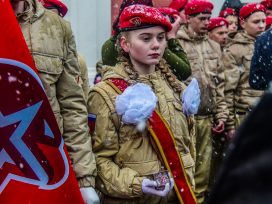
Intellectual violence
The militarization of education in Russia
Education has become another battleground in the Kremlin’s campaign to militarize the Russian public consciousness. Youth organizations, book bans, changes to school curricula – all amount to a ‘special anthropological operation’.
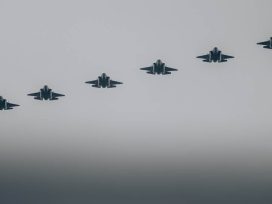
Russian drones entering Polish airspace, militarily seen as intensified provocation rather than open warfare, have nevertheless provoked costly responses – both from NATO’s air defence systems and civilian reactions to disinformation. A war correspondent’s view of what can be done technologically – for greater military efficiency and improved civil defence.

